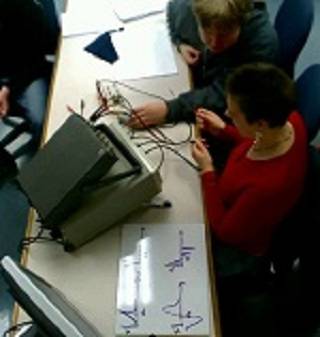You are here: start » activities » main
LRC Circuit: Impulse Driver
Highlights of the activity
- This integrated laboratory activity is designed to help upper-division undergraduate students understand the connection between an impulse driving voltage and a harmonic driving voltage.
- Students predict and then observe the current response (as measured by voltage across the resistor) of a series LRC circuit with an impulse driving voltage. They Fourier transform the current reponse to frequency space and compare to the admittance (resonance response) obtained withsingle-frequency sinusoidal driving voltages.
- The wrap-up discussion focuses on the connection between single and multiple-frequency driving voltages, and in particular how a delta function is a superposition of all single-frequency harmonics with equal amplitude.
Reasons to spend class time on the activity
This experiment is the simplest form of the modern spectroscopic method, and students are excited to learn this relevance. Students are fascinated to learn that ALL of the information about the frequency response of the series LRC circuit can be gleaned by studying the response to the impulse driver. In fact, this is the most consistent positive comment that comes out of evaluations of this exercise.
In addition to the impulse being viewed as a driving voltage that is an equal superposition of harmonic voltages at all frequencies, it also of course illustrated the free response of a damped oscillator. The system is given a kick, and then the force is removed. The classic “ringing” of the circuit is clearly observed. That this ringing signal Fourier transforms into the admittance function is one of the most profound, difficult and interesting things that the students learn.
